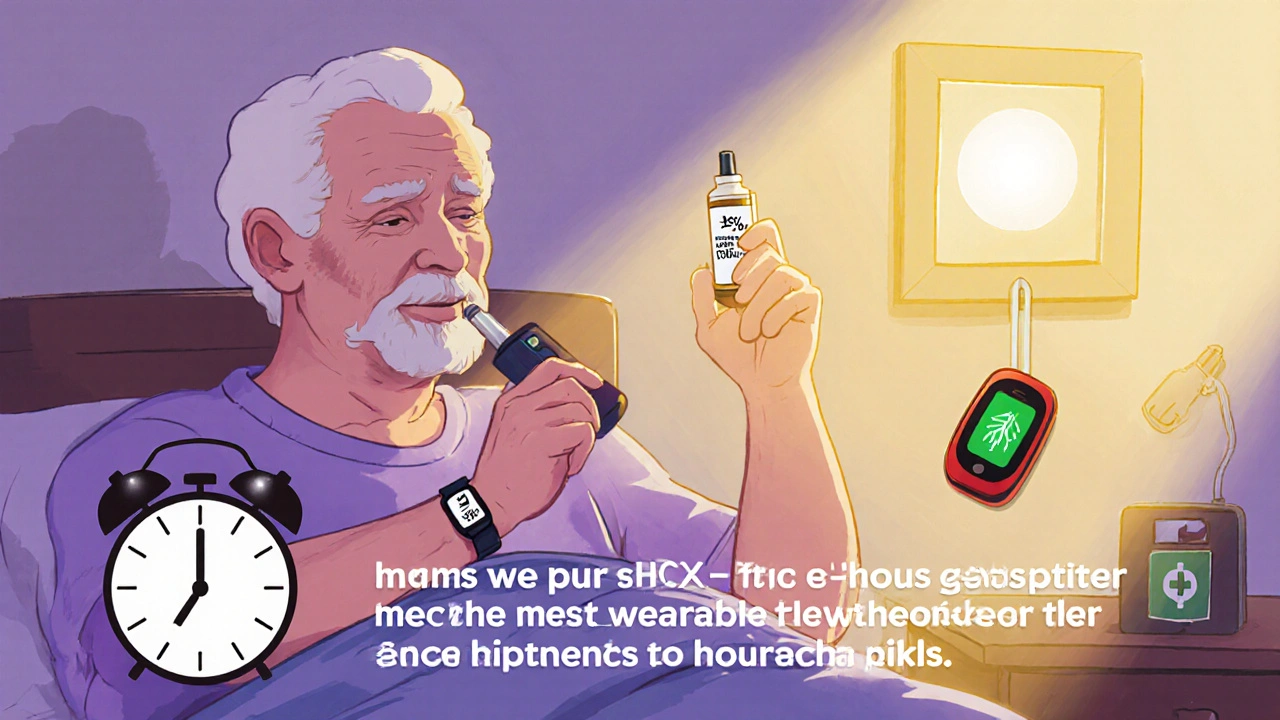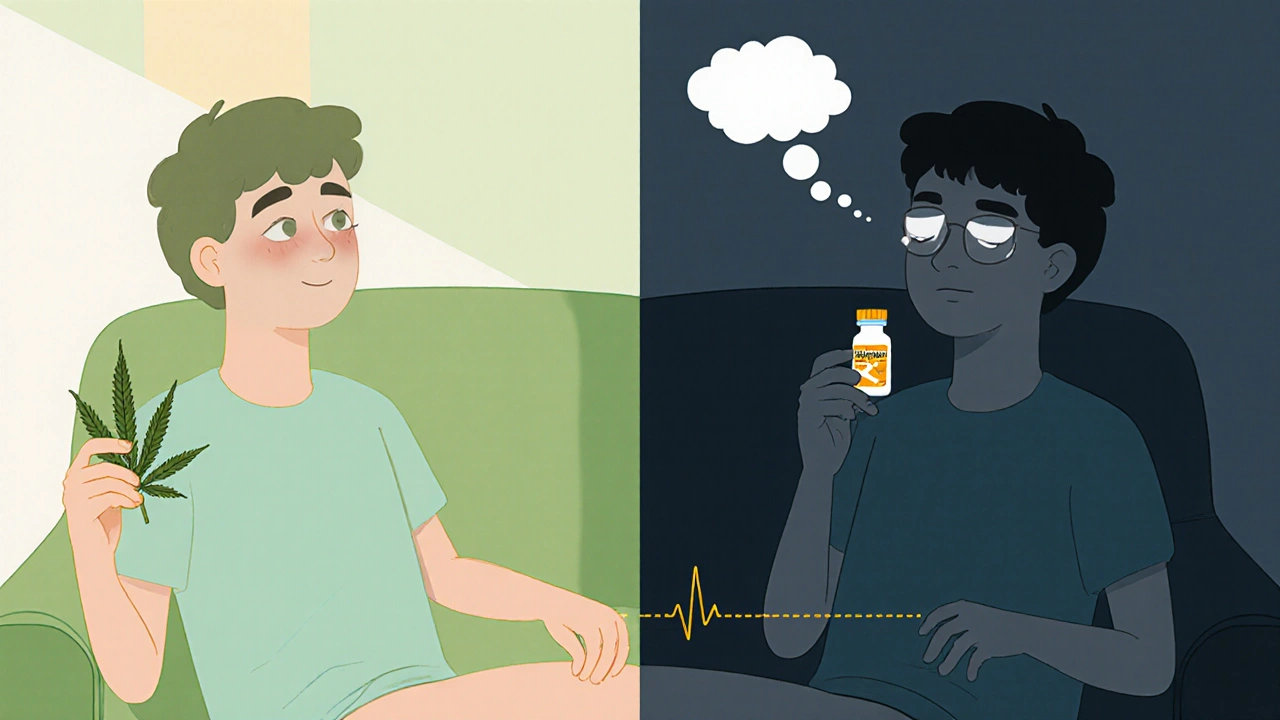CNS Sedation Risk Calculator
This calculator estimates your risk of additive sedation when combining cannabis with central nervous system depressants. The CNS Sedation Risk Score is a 10-point scale developed by medical professionals to identify patients at risk of respiratory depression and overdose.
Mixing cannabis with other central nervous system depressants can turn a mild chill into a dangerous overdose. The combination amplifies sedation, slows breathing, and clouds judgment, putting users at risk of emergency‑room visits or even death. This guide breaks down why the interaction happens, which drug groups are most hazardous, and what clinicians and patients can do to stay safe.
Cannabis is a plant‑derived substance containing cannabinoids such as delta‑9‑tetrahydrocannabinol (THC) that bind to CB1 receptors in the brain, producing relaxation, altered perception, and dose‑dependent sedation. CNS depressants are a class of drugs that enhance the activity of the inhibitory neurotransmitter gamma‑aminobutyric acid (GABA), leading to reduced neuronal firing, muscle relaxation, and drowsiness.How Cannabis Works as a Depressant
When THC activates CB1 receptors, it dampens excitatory signaling in regions that control attention, memory, and motor coordination. Even low doses (5‑10 mg THC) can slow reaction time and impair short‑term memory, effects that closely resemble those of alcohol and benzodiazepines. The onset is rapid when smoked (minutes) and slower but longer‑lasting with edibles (30‑90 minutes to peak, 6‑8 hours total). Because the depressive impact is dose‑dependent, a small extra puff can tip a user from “relaxed” to “extremely drowsy.”
Key CNS Depressant Families
Not all depressants act the same way, but they share the ability to deepen sedation when paired with cannabis. The most common groups are:
- Benzodiazepines (e.g., alprazolam, lorazepam)
- Opioids (e.g., morphine, oxycodone)
- Barbiturates (e.g., phenobarbital)
- Alcohol (often omitted in clinical tables but a frequent co‑use)
Why the Interaction Is Additive-Not Just Overlapping
Both cannabis and traditional depressants increase GABA‑mediated inhibition, albeit through different pathways. THC’s CB1 activation reduces glutamate release, while benzodiazepines directly boost GABA receptor opening. The result is a synergistic drop in cortical activity, meaning the combined effect is greater than the sum of each drug alone. The British Journal of Psychiatry (2020) reported a 3.2‑fold rise in emergency‑department visits for patients using both cannabis and benzodiazepines, with respiratory compromise accounting for two‑thirds of those cases.
Clinical Evidence of Additive Sedation
Several studies illustrate the real‑world danger:
- Journal of Clinical Medicine (2020): Patients on both cannabis and benzodiazepines had a 3.2× higher odds of an emergency visit compared with benzodiazepine‑only users (p < 0.01).
- Anesthesiology (2021): Cannabis‑using surgical patients required 20‑25% more propofol to reach target sedation but experienced 37% more post‑operative respiratory events.
- JAMA Internal Medicine (2022): A double‑blind trial of high‑CBD oil (150 mg CBD, <0.3% THC) showed no significant interaction with alprazolam, suggesting THC-not CBD-is the main driver of additive risk.
Risk Assessment Tools for Providers
To move from anecdote to systematic safety, professional societies have created scoring systems. The American Society of Health‑System Pharmacists (2023) offers a simple point‑based tool:
| Factor | Points |
|---|---|
| THC concentration 5‑10 % | 2 |
| THC concentration >10 % | 4 |
| Benzodiazepine | 3 |
| Opioid | 4 |
| Barbiturate | 5 |
| Age > 65 years | 2 |
| History of respiratory disease | 2 |
Scores above 7 flag a high‑risk scenario, prompting clinicians to either avoid the combination or enforce strict monitoring (e.g., pulse‑oximetry, staggered dosing).
Practical Safety Steps for Patients
If you or someone you care for uses cannabis together with a CNS depressant, follow these concrete tips:
- Ask your prescriber to document cannabis use on every medication chart.
- Prefer low‑THC products (<5 % THC) and avoid concentrates that can deliver 20‑30 mg THC in a single dose.
- Separate doses by at least four hours; start with the lowest possible dose of each drug.
- Never mix with alcohol or over‑the‑counter antihistamines that also cause drowsiness.
- Monitor breathing at night-use a wearable pulse‑oximeter if you have a history of sleep apnea.
- Keep emergency numbers handy; if you notice shallow breathing, skin turning blue, or inability to stay awake, call for help right away.
Guidelines from Major Medical Bodies
Regulators have started to codify these warnings:
- FDA issued a 2022 drug‑safety communication requiring label warnings on all prescription CNS depressants about potential cannabis interactions.
- European Medicines Agency (EMA) added similar warnings in 2023 for medical cannabis products marketed in the EU.
- The American Society of Anesthesiologists recommends avoiding cannabis within 72 hours of surgery and closely monitoring respiratory function when anesthetics and depressants are used together.
- The American Medical Association (2023) advises routine cannabis screening before prescribing benzodiazepines or opioids.

Special Considerations for Older Adults
People over 65 often take multiple medicines, making polypharmacy a real danger. Age‑related decline in hepatic metabolism means THC and depressants linger longer in the bloodstream. A recent analysis of Medicare data showed that seniors who combined cannabis with opioids had a 2.8× higher risk of fatal respiratory events compared with opioid‑only users. Even low doses of THC can push a borderline‑safe opioid regimen into the lethal zone.
Future Research Directions
Funding for interaction studies is climbing-NIH allocated $142.7 million in 2023 alone. Researchers are looking at:
- Standardized “interaction risk scores” that combine THC level, depressant type, and patient factors.
- Whether high‑CBD/low‑THC ratios truly neutralize the additive sedation effect.
- Genetic markers (e.g., CYP2C9 polymorphisms) that predict unusually high THC plasma concentrations.
These efforts aim to give clinicians clear, evidence‑based thresholds instead of vague warnings.
Bottom Line for Clinicians and Consumers
The chemistry is straightforward: cannabis and CNS depressants both quiet the brain, and together they can quiet it too much. Awareness, screening, and disciplined dosing are the only tools that keep the combination from becoming a fatal mistake.
Can I safely use a low‑THC cannabis product with a prescribed benzodiazepine?
Low‑THC (<5 %) products reduce risk but do not eliminate it. The safest approach is to keep a minimum 4‑hour gap between doses, start with the lowest possible benzodiazepine dose, and monitor for excessive drowsiness or breathing changes.
Do CBD‑only products interact with opioids?
Current data suggest high‑CBD, ultra‑low‑THC oils have negligible impact on opioid pharmacokinetics. However, patients should still inform their prescriber because CBD can affect liver enzymes that metabolize some opioids.
What are the warning signs of dangerous sedation?
Look for slow or shallow breathing (<10 breaths/min), inability to stay awake, slurred speech, confusion, blue‑tinged lips or fingertips, and extreme drowsiness that lasts more than 12 hours after dosing. If any appear, seek medical help immediately.
How should emergency rooms manage a patient who combined cannabis with an opioid?
Treat respiratory depression with naloxone as per opioid‑overdose protocols, but also monitor for prolonged sedation due to THC. Observation for at least 4 hours after reversal is recommended because cannabis effects can outlast naloxone’s half‑life.
Is there any benefit to combining cannabis with depressants under medical supervision?
In carefully controlled settings, low‑dose THC has helped some chronic‑pain patients lower opioid requirements by up to 47 %. Success hinges on strict dose titration, regular monitoring, and avoidance of high‑THC products.

junior garcia
October 24, 2025 AT 14:27Mixing weed with booze feels like setting your brain on a slow‑burn fuse-any second it blows.
Teya Arisa
October 28, 2025 AT 23:02Thank you for highlighting this vital issue. It is essential for clinicians to document cannabis use meticulously, as overlooking it can jeopardize patient safety. 🌿💊 Please encourage patients to be transparent, and consider employing standardized screening tools. 🙏
Kester Strahan
November 2, 2025 AT 07:36The pharmacodynamic synergy between cannabn Δ⁹‑THC and GABAergic agents is often underappreciated in clinical practise. THC’s CB1 agonism attenuates glutamatergic tone, which when coupled with benzodiazepine‑induced GABAA potentiation, yields a supra‑additive inhibitory cascade. Moreover, the cytochrome‑P450 isoforms, notably CYP2C9, mediate metabolic cross‑talk that can alter plasma concentrations of both substrates. In emergent settings, clinicians should employ a high‑resolution tox screen to discern co‑exposure, especially when patients present with hypoventilation. Neglecting these mechanistic nuances may precipitate iatrogenic respiratory compromise.
Doreen Collins
November 6, 2025 AT 16:10Indeed, the interplay you described underscores the need for vigilant monitoring, especially in poly‑pharmacy contexts; however, let me expand on how even low‑dose THC can subtly shift the dose‑response curve of benzodiazepines, thereby magnifying sedative outcomes beyond what one might intuitively predict.
Jordan Levine
November 11, 2025 AT 00:45Anyone still thinking it’s “just a chill vibe” needs to get their head out of the clouds – mixing depressants with cannabis is a recipe for disaster! 🚨💥
Mary Mundane
November 15, 2025 AT 09:19Simply put, mixing these substances is reckless and should be avoided.
Michelle Capes
November 19, 2025 AT 17:53I totally get why people want to relax, but thers a real risk of over‑sedation 😕. Make sure you talk to your doc and keep track of dosages!
Dahmir Dennis
November 24, 2025 AT 02:27Oh, wonderful, another casual evening of smoking a joint while sipping a nightcap.
Because nothing says 'I love my brain' like voluntarily dosing it with two powerful depressants at once.
First, THC lulls you into a dreamy state, slowing your reaction time and blurring your memory.
Then the benzodiazepine slides in, cranking the GABA receptors up to eleven.
The result is not a pleasant 'relaxed' feeling but a physiological tug‑of‑war that your respiratory centre struggles to arbitrate.
Your heart rate drops, your breathing becomes shallow, and your consciousness hovers on the edge of oblivion.
Medical literature, in case you haven’t read it, reports a three‑fold increase in emergency department visits for this exact cocktail.
Doctors who forget to ask about cannabis are essentially playing Russian roulette with patient safety.
Even a modest dose of THC can tip the scales, turning a therapeutic dose of an opioid into a potential overdose.
And let’s not ignore the fact that edibles have a delayed onset, so you might mistakenly consume more, thinking you’re still sober.
All this is compounded by individual variability – some people metabolize THC faster, others slower, making predictions a nightmare.
So if you value your ability to breathe, keep your mind clear, and avoid unnecessary hospital trips, steer clear of the mix.
If you’re already using both, the safest move is to stagger them, use the lowest possible doses, and have a sober monitor nearby.
In short, the combination is a high‑stakes gamble, and the house always wins when you ignore the science.
Take that as a friendly reminder that your health isn’t a casual experiment.
Jacqueline Galvan
November 28, 2025 AT 11:02Healthcare providers should incorporate a standardized cannabis exposure questionnaire into routine assessments, particularly when prescribing CNS depressants. This approach facilitates risk stratification and enables the implementation of monitoring protocols such as pulse‑oximetry during dose titration. Additionally, patient education on the additive sedative effects can empower informed decision‑making and reduce adverse events.
Tammy Watkins
December 2, 2025 AT 19:36Esteemed colleagues, the convergence of cannabinoids and traditional depressants constitutes a pharmacological tempest that demands our utmost vigilance. It is incumbent upon us to disseminate clear guidelines, calibrate dosing regimens, and foster interdisciplinary communication to avert catastrophic respiratory depression. Let us champion evidence‑based practices that safeguard our patients from the perilous synergy of these agents.
Dason Avery
December 7, 2025 AT 04:10Life’s balance is a delicate dance, and mixing substances can tip the scales toward chaos. 🌱 Embracing mindful consumption means honoring both the mind and the body, choosing safety over fleeting euphoria. Remember, the greatest high comes from clarity, not compromise.
Casey Morris
December 11, 2025 AT 12:45Indeed; one must consider, with meticulous scrutiny, the neurophysiological ramifications of concurrent cannabinoid and GABAergic agent administration; the resultant potentiation of inhibitory signaling, whilst ostensibly benign, may precipitate profound respiratory depression, thereby necessitating vigilant clinical oversight.